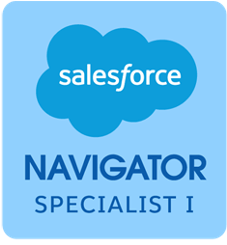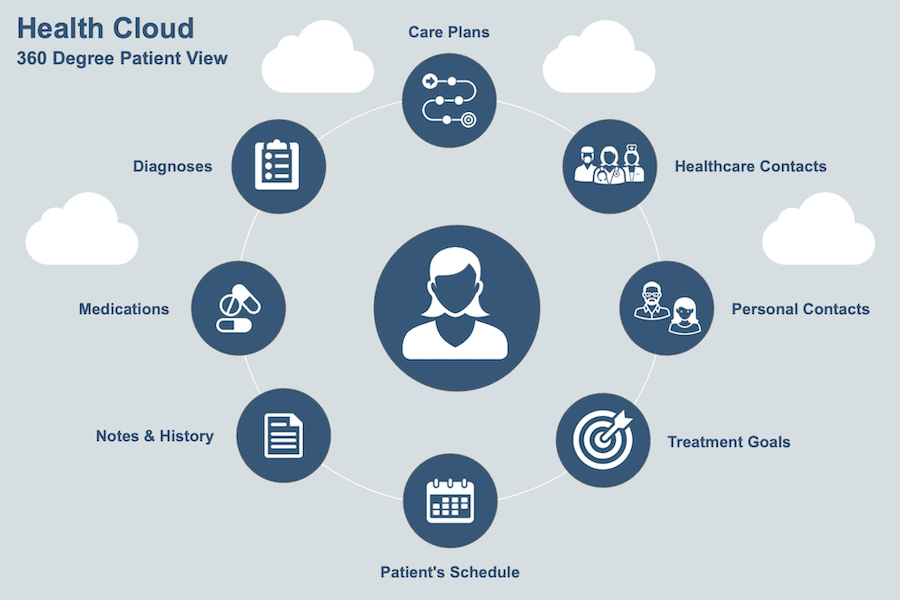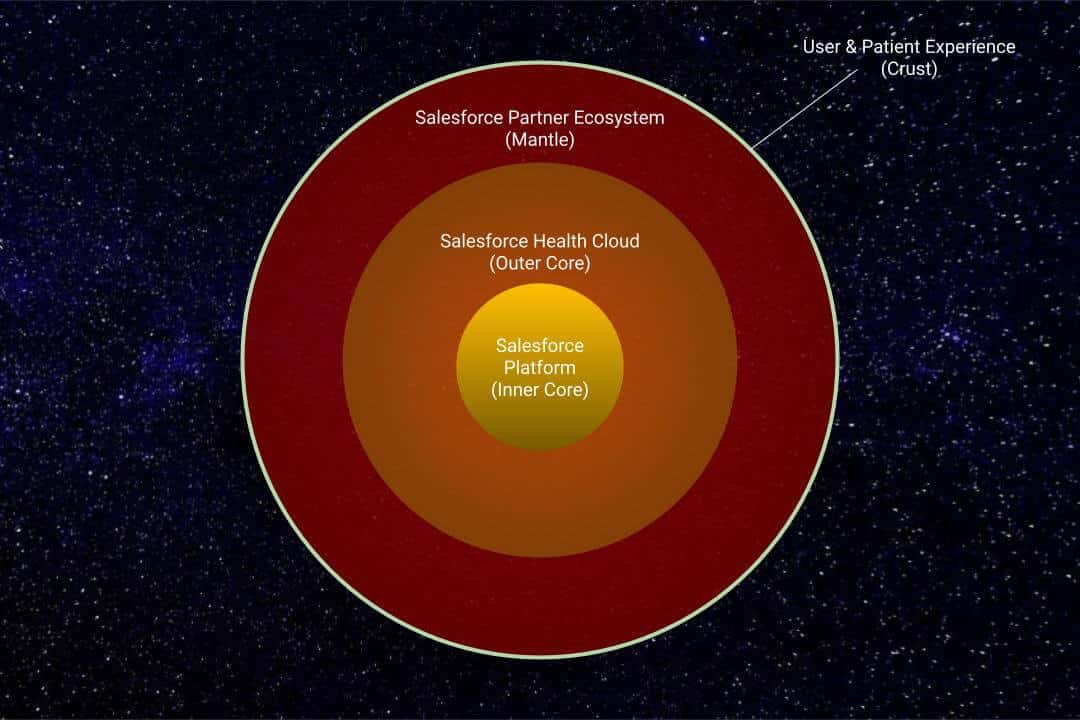If you are in the healthcare industry, “Health Cloud” from Salesforce is a product you may have heard about several times over the years. But you may only have a vague notion of what it can do.

In this post, we’ll look at the origins of Health Cloud and what the offering means today in practical terms. The moniker was coined by Salesforce, which announced the general availability of Salesforce Health Cloud at the HIMSS conference in February 2016.
Origins of ‘Cloud’
Let’s start with just the Cloud part.
Salesforce was instrumental in popularizing the word ‘Cloud’ as a metaphor in the tech industry. Initially, the term represented a shift from purchased, on-premises software applications to multi-tenant applications hosted in a data center and delivered via the internet. Software subscription, rather than software purchase, is associated with multi-tenancy.
With a connotation of puffy, fair-weather cumulus clouds against a blue sky, Cloud graphics served to represent an application served up outside of an organization’s physical location. Those external facilities are globally distributed data centers. In the case of Salesforce, the data centers are a combination of “Salesforce-managed” centers and Amazon Web Services (AWS).
Salesforce uses a Dodger blue image of a cloud that contains the word Salesforce in white letters as an iconic representation of the company’s brand. The cloud image remains prominent on all of Salesforce’s web properties, social media accounts, and partner logos.

The Expansion of Cloud-Based Functionality
A look at the history of Salesforce reveals that Salesforce began as a multi-user Sales Force Automation (SFA) application. Hence the company name.
SFA is a set of features & functionality that helps sales teams and business development staff organize daily activities, log the outcomes of various types of communications, forecast revenue, and even generate quotes & proposals.
Over time, Salesforce evolved into a technology platform for serving users across multiple departments within an organization, particularly in users’ interactions with customers.
The broader term Customer Relationship Management (CRM) replaced the term Sales Force Automation. In addition, the platform now provides a 360-degree view of the customer.
The number of silos of data within an organization could be decreased through many-to-one database consolidation into a CRM system. This meant more centralized access to data and fewer instances of redundant data entry.
For over two decades, Salesforce has rolled out bundles of functionality for different industries. These industries include financial services, manufacturing, consumer packaged goods, and healthcare & life sciences. Salesforce applied the word ‘Cloud’ to most of these products.
Learn about J2 Interactive’s Health Cloud services
Salesforce Health Cloud Today
Salesforce Health Cloud has continued to be the main brand for healthcare and life sciences applications.
Today, Health Cloud can be viewed as bundles of functionality that can be applied to a wide range of use cases for providers, payers, pharmaceuticals, and medical device companies — all ultimately relating to patients. The 360-degree view of the customer within corporations has been translated to the 360-degree view of the patient in healthcare.

You can expect to see 360 Degrees of Healthcare referenced frequently by Salesforce moving forward.
As Salesforce puts it, “Salesforce reimagined as a healthcare CRM seamlessly connects systems of record and improves visibility into the entire health journey, enabling personalized interactions that strengthen relationships and build trust with customers, whether they’re patients, members, providers, or partners.”
It’s worth mentioning that Health Cloud is not a replacement for an EHR system, but it can be integrated with an EHR using FHIR standards.
A Platform, Health Cloud, and a Partner Ecosystem
The user and patient experience is the visible part on top of the three underlying layers.

As an example of core functionality, Salesforce developed and has iterated a sophisticated Flow Builder that allows organizations to create and adhere to standardized processes.
One way this is applied to the Health Cloud layer is within Care Plans. Care Plans can provide standardized care for patients with similar conditions. It becomes easier to identify care gaps. For each Care Plan, a series of tasks designed to move a patient toward a goal can be set up and followed.
A multi-level information security model — referred to as “who sees what” — ensures that each user of the system only has access to patient data that they need.
Salesforce’s standard reporting and dashboards provide plenty of insights. Deeper, AI-driven insights are available with Tableau Analytics.
It’s becoming more common to see Salesforce Experience Cloud coupled with Health Cloud. There are many use cases for creating patient experiences on the Salesforce platform.
Salesforce Health Cloud is ever-evolving. Both Salesforce and its large partner ecosystem have been continually adding new capabilities — both as prepackaged apps and as custom solutions.
In terms of prepackaged functionality, a keyword search for “healthcare” on the Salesforce AppExchange reveals over 150 third-party apps with at least some connection to healthcare. We developed a native FHIR gateway for EHR integration.
In many cases, prepackaged functionality can be further customized for the precise needs of a healthcare or life sciences organization. When there isn’t anything available off-the-shelf to address a specific business requirement, a Health Cloud customer or a Salesforce Health Cloud consulting partner can develop fully custom functionality using Salesforce-provided declarative (no code) tools and coding tools.
What’s Next For The Platform?
Enhancing the patient experience has been a growing area of focus over the last several years for Salesforce, members of its ecosystem, and its customers.
You can expect to see many new creative, patient-centric solutions within healthcare organizations & life sciences companies for years to come.
Since mobile devices are essential for many situations and tasks, tools for creating experiences on smartphones and tablets will continue to evolve.
Professionally designed solutions that increase patient engagement
Frequently Asked Questions
Health Cloud is an experience platform for healthcare and life sciences organizations. A few of Salesforce Health Cloud’s many applications include appointment management, benefits & eligibility verification, medication management, care coordination, call triage, clinical study management, prior authorization, and home care management.
Organizations that use Health Cloud include Piedmont Healthcare, UnitedHealthcare, MIMIT Health, SCL Health, Beth Israel Lahey Health, and Summit Health.
The list price for Health Cloud Enterprise is $300 per user per month. The list price for Health Cloud Unlimited is $450 per user per month. Billing is annual.
Health Cloud is different from an EHR. However, many hospitals and clinics that use Health Cloud integrate the platform with one or more EHR systems.
Experience Cloud often works in conjunction with Salesforce Health Cloud. Experience Cloud extends an organization’s platform for secure, external user access. Examples of external users are patients, providers, and payers.



